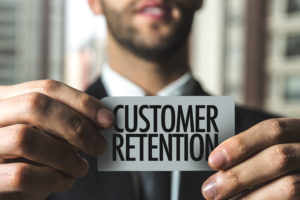When I first set out to build The Newsletter Pro, I was just looking to gain a few million dollars in revenue and gather a few new customers. I had a two-part, but very simple, marketing strategy to achieve this goal.

First, I decided to literally go business to business and set appointments. This strategy had nothing to do with how I wanted to market. It had everything to do with my need for new customers. I knew that if I used brute force and knocked on enough doors, I could close sales.
Next, I needed a marketing strategy that would drive leads. I’d said a hundred different times: “If I only had a great sales letter that could drive leads or an amazing online campaign. Then, I’d be set.” Those items are exactly what I set out to find.
I eventually found that, regardless of how amazing a silver bullet sounds, it actually is the worst thing you can have in your business. What happens when your silver bullet stops working? What happens if the government bans your silver bullet?
Personally, I was running a very successful business opportunity product via AdWords. Then, one day, I woke up, and AdWords had changed the rules, and within six months, my business was nearly 100 percent gone.
I thought I was a genius, but really, I was a chump. Today, a new generation of marketers are going to discover the same feeling when they wake up one day and Facebook no longer wants their business.
One of anything in a business is a curse, not a blessing.
I also learned that it is now more difficult than ever to grab someone’s attention — and even harder to have them make a first purchase with you.
Tony Robbins, the crazy-famous self-help guru, said that 10 years ago, it took four impressions on average to get someone to take notice of you. But in 2016, that number had quadrupled to 16 impressions.
Let that sink in for a second. Unless the person is in hot pursuit of what you’re selling, you need to reach out 16 times for them to take notice.
Tony isn’t the first person to point out that getting someone’s attention is becoming more and more difficult by the day, but it is an important fact that too many are ignoring — at their own peril.
The Truth Behind Why You’re Not Getting More New Customers
 I can solve new customer and business growth problems for most companies rather quickly. I don’t do much consulting anymore, but when I do, the reason these companies aren’t growing are often very similar.
I can solve new customer and business growth problems for most companies rather quickly. I don’t do much consulting anymore, but when I do, the reason these companies aren’t growing are often very similar.
Let’s start with growth. Most companies cannot give me the actual number of their attrition rate. They make crazy low-ball claims like 8 percent per year. Typically, my next question is, “What were the sales for the last two years, and how many new sales did you make last year?”
When you look at the numbers, they simply don’t add up. For example, say you have annual contracts and an 8 percent attrition rate, with $1,500,000 in sales $350,000 in new revenue. Then, I look at your total revenue number from 2 years ago, and you tell me you had $1,450,000 in sales.
There is no way you only have an 8 percent attrition rate. The numbers don’t lie.
Most people have no plan whatsoever to tackle customer attrition. Or, they’re delusional about their plan. They think providing good service or being the best provider of something is going to keep those new customers coming back.
Let me tell you the truth. It won’t. Everyone thinks they are the best and have great service.
Personally, I use and obviously recommend that businesses use newsletters as a foundation for a relationship marketing campaign. If you don’t want to use that, fine, but stop doing nothing.
Your customer attrition number is one of the top 5 most important numbers in your business if you want to stop losing business to your competitors. To start growing faster than you likely thought possible, know that attrition number and create a plan to lower it.
More New Customers
 Most businesses give up on leads way too early. Here at The Newsletter Pro, 29 percent of our new sales last year had been on our list for 12 months or longer. That is huge — millions in new revenue to us.
Most businesses give up on leads way too early. Here at The Newsletter Pro, 29 percent of our new sales last year had been on our list for 12 months or longer. That is huge — millions in new revenue to us.
Stop giving up so early. You need to follow up with people. Depending on the value of a sale for you and your sales cycle, you may need to follow up for 12 months or longer.
I recently spoke with a guy who sells online marketing services. He told me over a dozen new sales last year came from people who had been on his list for longer than 5 years. Now, that may be too long to leave someone on your list, but for him, obviously it isn’t.
If you want to see real customer growth, stop throwing away all the money you’ve spent on lead generation simply because they didn’t buy on your first or second offer. It’s completely plausible they never even saw it, especially if your follow-up was all online. Times have changed, and your business needs to adjust with the changes.
But How Do You Track ROI On That?
 The sheer volume of touches needed is why ROI tracking has become so difficult.
The sheer volume of touches needed is why ROI tracking has become so difficult.
Let’s use my company as an example.
Did those new sales happen to get an amazing article from me in the newsletter that converted them? Or, was it all the touches combined over time? Were they just waiting for that last email to sign up.? Or, was it the value I’ve been adding to their lives and or business?
We don’t live in a simple world. Simple ROI is hard to come by. It’s okay to have some pieces that play the long game and some pieces that have a primary goal of immediate ROI. You just need to distinguish the two in the budget.
What I’m teaching here is not sexy; it’s not shiny, and it’s not new. But it works. If you are tired of losing new customers to the competition, you need to take note and take action.
Big Business Vs. Small Business
 Recently I was sitting with my coach and chatting about business. My coach is the CEO of a $130,000,000-per-year business. He said one of the most important numbers to a venture capitalist is attrition rate. A bad attrition number typically means a drastically lower valuation, regardless of how good any of the other numbers are.
Recently I was sitting with my coach and chatting about business. My coach is the CEO of a $130,000,000-per-year business. He said one of the most important numbers to a venture capitalist is attrition rate. A bad attrition number typically means a drastically lower valuation, regardless of how good any of the other numbers are.
It struck me as odd that big businesses focus on attrition. Unfortunately, most of us small businesses almost completely ignore it.
Does your plan for growth include long-term multi-channel follow-up? Do you have a budget (separate from your marketing budget) that plans for attrition?
If not, there is nothing more important for you to be working on then that. No new marketing should be implemented until you have these pieces in place. Who knows? You could end up with 29 percent additional growth from the marketing you’re already doing by the end of the year.
Nothing will happen, though, unless you take action on what you already know you should be doing.
To discover a tool that will slow customer attrition and grow your business, request a complimentary copy of our book, The Ultimate Guide to Newsletters.






